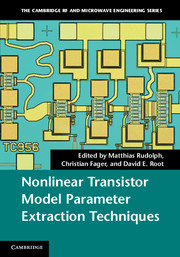Book contents
- Frontmatter
- Contents
- List of contributors
- Preface
- 1 Introduction
- 2 DC and thermal modeling: III–V FETs and HBTs
- 3 Extrinsic parameter and parasitic elements in III–V HBT and HEMT modeling
- 4 Uncertainties in small-signal equivalent circuit modeling
- 5 The large-signal model: theoretical foundations, practical considerations, and recent trends
- 6 Large and packaged transistors
- 7 Nonlinear characterization and modeling of dispersive effects in high-frequency power transistors
- 8 Optimizing microwave measurements for model construction and validation
- 9 Practical statistical simulation for efficient circuit design
- 10 Noise modeling
- Index
- References
1 - Introduction
Published online by Cambridge University Press: 25 October 2011
- Frontmatter
- Contents
- List of contributors
- Preface
- 1 Introduction
- 2 DC and thermal modeling: III–V FETs and HBTs
- 3 Extrinsic parameter and parasitic elements in III–V HBT and HEMT modeling
- 4 Uncertainties in small-signal equivalent circuit modeling
- 5 The large-signal model: theoretical foundations, practical considerations, and recent trends
- 6 Large and packaged transistors
- 7 Nonlinear characterization and modeling of dispersive effects in high-frequency power transistors
- 8 Optimizing microwave measurements for model construction and validation
- 9 Practical statistical simulation for efficient circuit design
- 10 Noise modeling
- Index
- References
Summary
If one is about to design a circuit, one certainly relies on a circuit simulation tool that provides us with the capability to determine circuit performance with high accuracy without even fabricating a prototype. We expect the simulation to provide us with the numerical algorithm that is capable of accurately calculating the relevant variables, such as currents, voltages, noise, distortion products, etc. At least as important is the description of the components that will be used, since ultimately the simulation can never be more accurate than the models of the components used. Component models commonly are provided as drag-and-drop components in modern circuit simulators. At least for established technologies, accurate models are available for passive and active components. All problems solved?
Unfortunately not. The models, especially compact transistor models, are parametrized. It is a big step from the general-purpose model that is capable of describing, say, SiGe heterojunction bipolar transistors (HBTs) in general to the specific model for a specific transistor of a specific size, from a specific foundry, that one plans to use in the actual design.
But why bother? One would expect the foundry selling the transistor also to provide us with a valid model.
In reality the situation is more like the following:
Some vendors simply do not provide their customers with appropriate models. Either one gets just plain data sheets providing some figures of merit and printed S-parameters. Or quite often, even for the most advanced transistors, only very basic SPICE-type model parameters are provided. While these models are available in literally all circuit simulators, their accuracy is often quite limited, since these models only describe the very basic transistor behavior.
[…]
Information
- Type
- Chapter
- Information
- Publisher: Cambridge University PressPrint publication year: 2011
References
Accessibility standard: Unknown
Why this information is here
This section outlines the accessibility features of this content - including support for screen readers, full keyboard navigation and high-contrast display options. This may not be relevant for you.Accessibility Information
- 1
- Cited by
